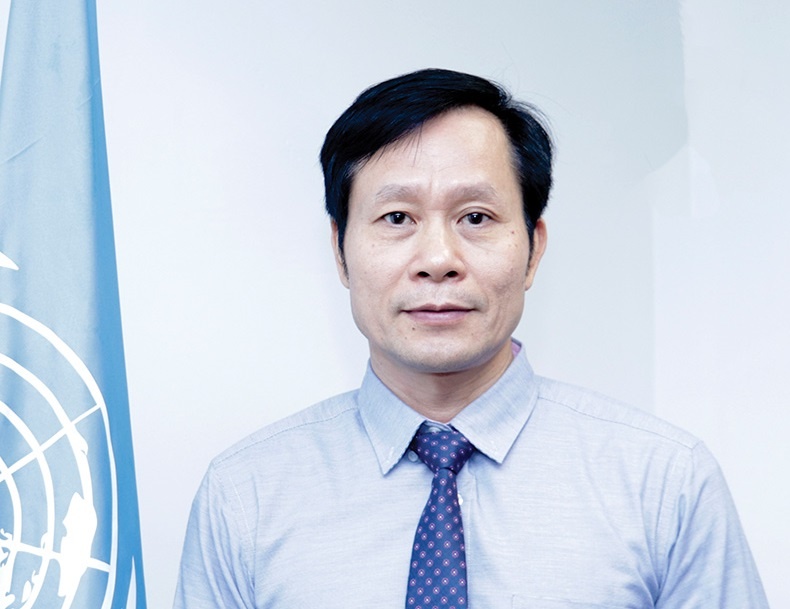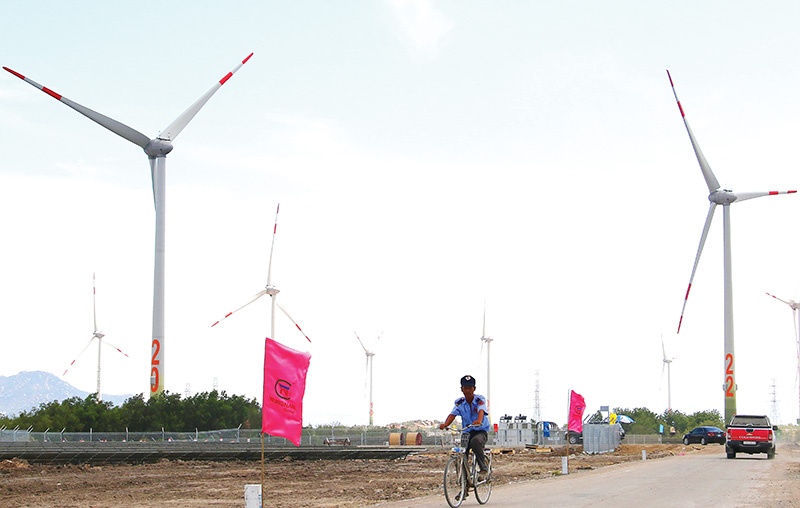Gearing up towards a just energy transition in Vietnam
 |
| Dao Xuan Lai, assistant resident representative and head of the Climate Change and Environment Unit at the United Nations Development Programme in Vietnam |
In his concluding statement at the COP26 climate summit in Glasgow last November, United Nations Secretary General António Guterres warned, “We are knocking on the door of climate catastrophe.”
At the summit, Prime Minister Pham Minh Chinh announced Vietnam’s ambitious and highly commendable commitments, most notably the national target of net-zero emissions by 2050. Vietnam also joined other countries to issue declarations committing to “end all investment in new coal power generation, scale up deployment of clean power generation, phase out coal power by the 2040s, and make transitions away from coal power that benefit workers and communities.”
These are significant ambitions and provide a potential model for developing countries to pursue green and inclusive recovery from COVID-19 and avoid catastrophic climate change. For middle-income countries like Vietnam, however, climate change mitigation should not come at the expense of economic development and improving the lives of the poor. As the prime minister noted in his COP26 speech, it is essential to ensure equity and justice in our response to climate change.
Vietnam’s ultimate priority is adaptation to the current and expected impacts of climate change. According to a recent climate expenditure and investment report produced jointly by the Ministry of Planning and Investment and the United Nations Development Programme, Vietnam has allocated increasing financial resources for climate change response.
Ministry budgets for adaptation account for over 70 per cent of their total climate change finance, and this rises to more than 90 per cent for provinces. Total expenditures on adaptation by the six ministries and 29 provinces and cities covered in the report reached almost $6.5 billion between 2016 and 2020, or an average of $1.3 billion per year.
 |
| Long-term climate-based finance is the key for Vietnam to reach its ambitious green goals, Photo: Le Toan |
Endowed with riches
In Vietnam, 26 coal-fired power plants were in operation by 2020 with a combined capacity of 21,300MW, according to the revised Power Development Plan VII (PDP7) for the period 2011-2020 and vision to 2030. According to a draft of the new PDP8 for the period 2021-2030 and vision to 2045, another 27 coal power plants with a total capacity of 31,000MW might be built to meet the economy’s growing energy demands.
Each coal power plant of 1,200MW would provide between 2,000 and 2,500 jobs during construction and 600-900 jobs once put into operation. The draft PDP8 is now being revised to align with Vietnam’s COP26 commitments.
The country is also endowed with rich coal mines and has a large coal mining sector, which provide many jobs and have undeniably contributed to the country’s near-miraculous rate of poverty reduction in recent decades. One report shows that more than 100,000 workers have been employed by coal mines in the northeastern province of Quang Ninh alone.
According to the revised development plan of the coal sector from 2016, the coal demand was projected to be 81.3 million tonnes in 2020, 110.9 tonnes in 2025, and 144.7 million tonnes by 2030. This development plan will also need to be revised to ensure full alignment with Vietnam’s new climate targets.
Hard choices will have to be made. The shift away from coal will unquestionably require adaptability, and some workers will need to acquire new skills to seize new opportunities. Land previously used for mining, for example, might be converted to agricultural uses to benefit smallholder farmers. This is, however, an excellent opportunity to change course with an eye to the future health and prosperity of the nation.
If Vietnam is to meet the energy needs of the economy while delivering its COP26 climate commitments, it will need to significantly expand the development of renewable energy sources. In addition, the country will need to start working on a plan to phase out coal in the coming years. It will not be possible to achieve these ambitious changes without new and additional long-term climate finance.
Unfortunately, climate finance remains a major obstacle in responding to climate change. The promise to mobilise at least $100 billion per year by 2020 to support developing countries in reducing emissions and adapting to climate change was not fulfilled. A recent report by the Organisation for Economic Co-operation and Development concludes that in 2019, only about $80 billion in climate finance was provided.
Ultimately, countries like Vietnam will rely mostly on domestic sources for climate finance. Domestic banks have been the main source of finance for solar and wind power projects, accounting for $3.6 billion in investments between 2018 and 2020. Continued expansion of solar and offshore wind will, however, require modernising the national grid, developing regional micro-grids and electricity storage, and conducting structural reform of the energy market. To achieve this, Vietnam would need an estimated $33 billion over 10 years.
Safeguarding livelihoods
There are opportunities to mobilise international climate finance. At COP26, South Africa provided an example of using an innovative partnership and a target-oriented programme approach to mobilise a new climate financing package of $8.5 billion over five years. South Africa’s just transition energy partnership aims to enable the development of a low-carbon and climate-resilient economy that is shifting away from dependence on fossil fuels.
The government plays a vital role in creating policy frameworks to stimulate and direct capital towards green energy development. It can, for example, introduce innovative schemes to mobilise resources from domestic and international business sectors and the people of Vietnam, for example through green and blue bonds, carbon markets, and carbon taxes.
Energy transition requires participation and contribution business sector, but also creates great potential economic opportunities for businesses. The businesses can contribute by fostering research and development, technology innovation, and investment in renewable energy.
New economic sectors and markets will open up, for example hydrogen is currently enjoying a renewed and widespread momentum in many national policies. A low-carbon hydrogen economy presents potential opportunities not only to reduce climate change, but also to enhance energy security and develop local industries.
Climate justice requires us not only to fully recognise the impacts and needs of the most vulnerable communities, but also to actively protect them from adverse material and economic effects. The energy transition must address inequality by ensuring the creation of new jobs, safeguarding the livelihoods of those who are impacted by the shift away from fossil fuels, assessing mitigation and adaptation effects, and addressing environmental and social impacts so that no-one is left behind.
A just transition calls for a systemic approach, creating innovative partnerships between the state, private sector, and civil society, collaboration to foster innovation and creative processes, evaluation of tech and environmental risks, access to finance for pre-commercial opportunities, participation of small- and medium-size businesses, and de-risking measures.
Vietnam’s COP26 climate targets are an opportunity to re-orient the nation’s economy along a just, sustainable, high-productivity trajectory. They are ambitious but achievable with the continuous strong leadership of the Party and the government combined with support and contributions from the business sector, international development partners, and the people of Vietnam.
The country’s success in meeting its targets in the years ahead will require a robust system of climate governance and finance for a just energy transition.
What the stars mean:
★ Poor ★ ★ Promising ★★★ Good ★★★★ Very good ★★★★★ Exceptional
Related Contents
Latest News
More News
- Schaeffler reports strong early output from Dong Nai solar project (December 12, 2025 | 15:16)
- Forestry conference highlights biodiversity and sustainability goals (December 09, 2025 | 13:35)
- Home Credit honoured among top 10 sustainable companies in trade and services (December 09, 2025 | 12:18)
- SCG and seven member companies honoured in Top 100 Sustainable Businesses 2025 (December 08, 2025 | 09:00)
- Nestlé Vietnam pioneers sustainable development and promotes business connections (December 06, 2025 | 12:09)
- CSI 2025 highlights rise of Vietnam’s green champions (December 06, 2025 | 09:00)
- Acecook Vietnam named among top 100 sustainable businesses (December 06, 2025 | 08:00)
- Vietnam’s forest carbon credits draw global interest (December 05, 2025 | 17:41)
- Coro Energy to launch BESS Pilot in Vietnam (December 04, 2025 | 15:12)
- Vietnam strengthens energy storage pathway (December 04, 2025 | 15:05)

 Tag:
Tag:






















 Mobile Version
Mobile Version